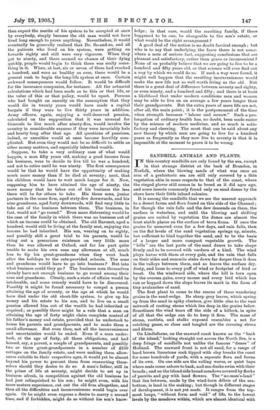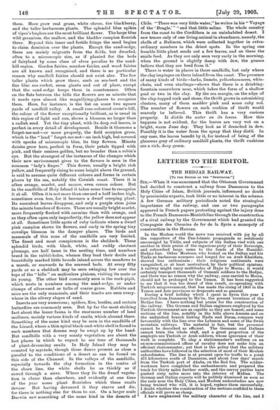SANDHILL ANIMALS AND PLANTS.
IN this country sandhills are only found by the sea, except in that strange district at the back of Brandon, in
Norfolk, where the blowing sands of what was once an arm of a prehistoric sea are still only covered by a thin vegetation akin in some respects to that of the coast, where the ringed plover still comes in to breed as it did ages ago, and some insects commonly found only on sand dunes by the shore have their little inland colonies.
It is among the sandhills that we see the nearest approach to a desert fauna and flora found on this side of the Channel ; for though the rain falls and the dew descends on them, the surface is waterless, and until the blowing and shifting grains are united by vegetation the dunes are almost the least stable places on the surface of terra firma. If once the grains lie unmoved even for a few days, and rain falls, then on the flat levels of the sand vegetation springs up, minute, but sufficient to bind together the sand, and to be the basis of a larger and more compact vegetable growth. The " hills " are the last parts of the sand dunes to take shape firmly and to be covered with verdure of a kind. The wind plays havoc with them at every gale, and the rain that falls on their sides and summits sinks down far deeper than it does in the valleys between them, and so leaves the surface dry, dusty, and loose to every puff of wind or footprint of bird or beast. On the windward side, where the hill is torn open by the oversea gales, every mouse and every bird which has run or hopped down the slope leaves its mark in the form of tiny avalanches of sand.
The first plant to come to the rescue of these wandering grains is the sand-sedge. Its sharp grey leaves, which spring up from the sand in spiky clusters, give little clue to the vast network of rooting stems which lies deep in the grains below. Sometimes the wind tears off the side of a hillock, in spite of all that the sedge can do to keep it firm. The mass of stems, rootlets, and stalks exposed resembles a net for catching game, so close and tangled are the crossing stems and fibres.
On Lindisfarne, on the seaward coast known as the "back
of the island," looking straight out across the North Sea, is a deep fringe of sandhills not unlike the famous "dunes" of Holland. The seaward front is not all sand, for a range of hard brown limestone rock tipped with clay breaks the coast for some hundreds of yards, with a separate flora and fauna of its own. On one side are the rolling waves, or quiet bays where seals come ashore to bask, and sea-ducks swim with their broods ; and on the island side broad meadows covered by flocks of peewits and gay with land flowers. The "no-man's-land" that lies between, made by the wind-born debris of the sea- bottom, is land in the making; but though in different stages of development, it is not yet made. It ranges from the top- most heaps, "without form and void" of life, to the lowest levels by the meadows within, which are almost identical with them. Here grow real grass, white clover, the blackberry, and the taller herbaceous plants. The splendid blue spikes of viper's bugloss are the most brilliant flower. The large blue wild geranium, the mallow, and the bladder campion flourish there. Beyond this inner and fertile fringe the sand begins to claim dominion over the plants. Except the sand-sedge, these are mainly migrants from the fields, but dwarfed, often to a microscopic size, as if planted for the beds of fairyland by some class of elves peculiar to the sand- hill region. Garden fairies, meadow fairies, and wood fairies are all known and recognised, and there is no particular reason why sandhill fairies should not exist also. The few taller plants which grow there, such as sea-beet and the fine lilac sea-rocket, seem giants and out of place, except that the sand-sedge keeps them in countenance. Often on the flats between the hills the flowers are so minute that it needs eyes almost like magnifying-glasses to recognise them. Here, for instance, is the list on some two square yards of sandhill valley. A small rose-coloured crane's-bill, the colour of the flower exceptionally brilliant, as is usual in this region of light and sun, shows a blossom no larger than a radish seed. Yet the tiny plant, with its deep red leaves, is perfect in every detail of development. Beside it blossoms a forget-me-not—or more properly, the field scorpion grass, which is the " land " forget-me-not—an inch high, but covered with specks of microscopic blue, its tiny flowers. Minute daisies grow here, perfect in form, their petals tipped with pink, and their centres golden, but no broader than a robin's eye. But the strangest of the instances of the changes which their new environment gives to the flowers is seen in the common "lady's finger." This flower, usually a bright rich yellow, and frequently rising to some height above the ground, is said to assume quite different colours and forms in certain places by the sea, notably, the Cornish coast. There it is often orange, scarlet, and mauve, even cream colour. But in the sandhills of Holy Island it takes some time to recognise it at all. Often it is not more than one and a half inches high, sometimes even less, for it becomes a dwarf creeping plant. Its succulent leaves disappear, and only a purple stem joins the minute bunches of flowers. These are usually bright scarlet, more frequently flushed with carmine than with orange, and as they often open only imperfectly, the yellow does not appear at all. Sometimes little spots of ruby indicate where a dwarf pink campion shows its flowers, and early in the spring tiny cowslips blossom in the damper places. The birds and mammals of this zone of the sandhills are very limited. The finest and most conspicuous is the shelduck. These splendid birds, with black, white, and ruddy chestnut plumage, are half tame in the nesting time, and numbers breed in the rabbit-boles, whence they lead their docile and beautifully marked little broods inland across the meadows to a marsh, or seawards to the seaweed beds. At every fifty yards or so a shelduck may be seen swinging low over the tops of the " hills " on motionless pinions, visiting its mate or its young. The other bird commonly seen is the rock-pipit, which nests in numbers among the sand-sedge, or under clumps of silverweed or tufts of coarse grass. Rabbits and mice are the only mammals, and their tracks are seen every- where in the silvery slopes of sand.
Insects are very numerous; spiders, flies, beetles, and certain butterflies are commonly seen. But by far the most striking fact about the lesser fauna is the enormous number of land molluscs, mainly various kinds of snails, which abound there. Something of the same kind may be seen in the sandhills of the Lizard, where a thin spiral black-and-white shell is found in such numbers that dozens may be swept up by the band- But sandhills with a very scanty vegetation are about the last places in which to expect to see tens of thousands of plant-devouring snails. In Holy Island they may be counted by myriads, though these dunes present as close a parallel to the conditions of a desert as can be found on this side of the Channel. In the valleys of the sandhills, especially towards the clay formation in the centre of the shore line, the white shells lie as thickly as if sowed through a sieve. Where they lie the dwarf vegeta- tion is closer than elsewhere, and evidently at one time of the year some plant flourishes which these snails devour. But having devoured it they starve and die, for there is nothing else for them to eat. On a larger scale Darwin saw something of the same kind in the desert's of Chile. "There was. very little water," he writes in his "Voyage of the Beagle,' " "and that little saline. The whole country from the coast to the Cordillera is an uninhabited desert. I saw traces only of one living animal in abundance, namely, the shells of a Bulimus, which were collected together in extra- ordinary numbers in the driest spots. In the spring one humble little plant sends out a few leaves, and on these the snails feed. As they are only seen very early in the morning, when the ground is slightly damp with dew, the guasos believe that they are bred from it."
There is water in places in these sandhills, but only where the clay impinges on them inland from the coast. The presence of many kinds of birds—larks, linnets, yellowhammers, whin- chats, and even starlings—shows that there is a drinking- fountain somewhere near, which takes the form of a shallow pool or two in the clay. By the sea margin, on the edge of the clay-topped rock and stone, the thrift grows in astonishing clusters, many of them madder pink and some ruby red. The number of flowers on each cushion of thrift would scarcely be believed. This thrift has a very curious property. It distils the water on its leaves. How this happens is not evident, for the leaves are very wet on a bright, warm June day. They look as if drenched in dew. Possibly it is the water from the spray that they distil. In any case, the leaves benefit by it, for instead of being of the glaucous grey of ordinary sandhill plants, the thrift 'cushions are a rich, deep green.







































 Previous page
Previous page